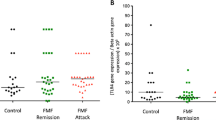Abstract
The role of regulatory T cells (T-regs) in familial Mediterranean fever (FMF) was never evaluated. Preliminary studies that we have conducted suggested a rise in the number of regulatory T cells after FMF attacks reaching a maximal level at 7 days. The aim of this study was to evaluate the percentage and activity of regulatory T cells in FMF. Six patients with refractory FMF and six healthy controls were evaluated. The percentage of T-reg cells and forkhead box protein 3 (Foxp3) expression was evaluated and compared between four states: FMF in remission, FMF at the first day of an attack, FMF 7 days after the start of the attack, and healthy controls. Four females and two males were included. All patients had FMF with high severity score, 2.8 ± 0.4 (0–3). The mean age was 31.6 ± 6.2. The mean age at onset was 9.3 ± 9.3. The mean colchicine dose was 2.6 mg ± 0.4. The expression of Foxp3 7 days after the attacks was significantly higher than in FMF at the first day of the attack, FMF in remission, and healthy controls 10.08 ± 2.36 vs. 7.005 ± 0.3 vs. 5.3 ± 1.06 vs. 4.44 ± 1.8; p < 0.05 (Fig. 1). The percentage of T-regs in peripheral blood was not statistically different between the four groups. Theexpression of Foxp3 by T-regs increases 7 days after attacks of FMF. Anti-inflammatory cytokines interleukin-10 and TGF-β are known to activate T-regs and have been reported to increase in FMF attacks in line with the present findings. It is suggested that T-regs may have a role in terminating FMF attacks.


Similar content being viewed by others
References
Livneh A, Langevitz P, Zemer D et al (1997) Criteria for the diagnosis of familial Mediterranean fever. Arthritis Rheum 40:1879–1885
The International FMF Consortium (1997) Ancient missense mutations in a new member of the RoRet gene family are likely to cause familial Mediterranean fever. Cell 90(4):797–807
The French FMF Consortium (1997) A candidate gene for familial Mediterranean fever. Nat Genet 17:25–31
Aypar E, Ozen S, Okur H, Kutluk T, Besbas N, Bakkaloglu A (2003) Th1 polarization in familial Mediterranean fever. J Rheumatol 30(9):2011–2013
Erken E, Ozer HT, Gunesacar R (2006) Plasma interleukin-10 and interleukin-12 levels in patients with familial Mediterranean fever. Rheumatol Int 26(9):862–864
Manukyan GP, Ghazaryan KA, Ktsoyan ZhA et al (2008) Cytokine profile of Armenian patients with familial Mediterranean fever. Clin Biochem 41(10–11):920–922
Slobodin G, Ahmad MS, Rosner I et al (2010) Regulatory T cells (CD4(+)CD25(bright)Foxp3(+)) expansion in systemic sclerosis correlates with disease activity and severity. Cell Immunol 261(2):77–80
Yamaguchi T, Wing JB, Sakaguchi S (2011) Two modes of immune suppression by Foxp3(+) regulatory T cells under inflammatory or non-inflammatory conditions. Semin Immunol 23(6):424–430
Saadoun D, Rosenzwajg M, Joly F et al (2011) Regulatory T-cell responses to low-dose interleukin-2 in HCV-induced vasculitis. N Engl J Med 365(22):2067–2077
Duan W, So T, Mehta AK, Choi H, Croft M (2011) Inducible CD4+LAP+Foxp3− regulatory t cells suppress allergic inflammation. J Immunol 187(12):6499–6507
Rimar D, Rosner I, Slobodin G, Boulman N, Rozenbaum M (2010) Regulatory T-cells in familial Mediterranean fever (FMF). 6th International Congress of FMF and SAID, Amsterdam, the Netherlands, Sept 2–6. Poster L1.44
Hein F, Massin F, Cravoisy-Popovic A et al (2010) The relationship between CD4+CD25+CD127− regulatory T cells and inflammatory response and outcome during shock states. Crit Care 14:R19
Mielke S, Rezvani K, Savani BN et al (2007) Reconstitution of FOXP3+ regulatory T cells (Tregs) after CD25-depleted allotransplantation in elderly patients and association with acute graft-versus-host disease. Blood 110(5):1689–1697
Disclosures
None.
Author information
Authors and Affiliations
Corresponding author
Rights and permissions
About this article
Cite this article
Rimar, D., Rosner, I., Slobodin, G. et al. The role of regulatory T cells in familial Mediterranean fever (FMF). Clin Rheumatol 31, 885–888 (2012). https://doi.org/10.1007/s10067-011-1935-7
Received:
Revised:
Accepted:
Published:
Issue Date:
DOI: https://doi.org/10.1007/s10067-011-1935-7



